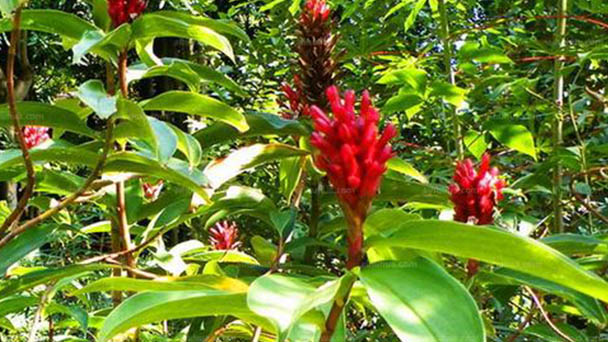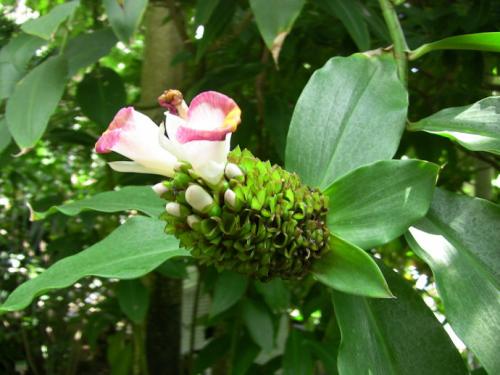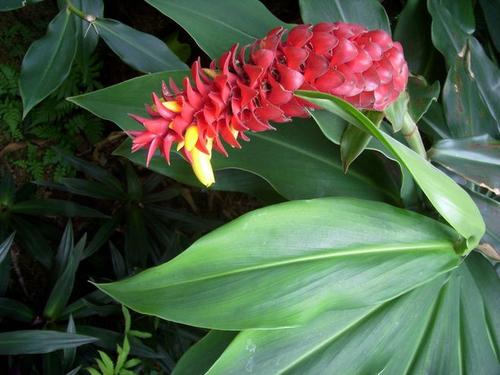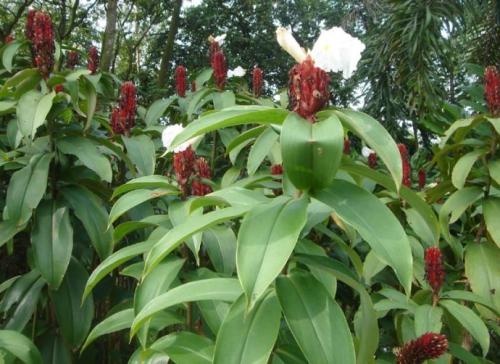Crepe ginger (Costus speciosus) profile
Written by Maggie
Mar 22 2021

Crepe ginger (Costus speciosus (Koen.) Smith) is a perennial herb of the genus Crepe ginger of the Zingiberaceae. It is a perennial herb of the genus Crepe ginger of the family, which is widely distributed in Taiwan, Guangdong, Guangxi, Yunnan and other provinces and regions in China. Crepe ginger is mainly used for fresh cut flowers, dry flowers and garden greening. The annual yield of fresh cut flowers is as high as 15,000-20000 sticks per acre, and the bottling period is as long as 15-20 days. Because of its unique red leathery spike shape, Crepe ginger is easy to make into dried flowers, which is a good dried flower material. It is planted in courtyard communities, parks, flower beds, etc., growing lush, after the flowers Tingting Yuli, very elegant.
Crepe Ginger likes to grow in warm, humid conditions and is native to tropical Asia. crepe ginger is mainly used for fresh cut flowers, dried flowers and garden greening, medicine and other purposes.
Crepe ginger picture

Morphological characteristics of crepe ginger
Branch
Crepe ginger is a perennial herb, 1 -- 3 m tall, nearly woody at base, often branched at top, convolute.
Leaf
Leaves of Crepe ginger are oblong or lanceolate, 15 -- 20 cm long and 6 -- 10 cm wide, apically acuminate or caudate-acuminate, base suborbicular, back densely sericeous.
Flowers
Crepe ginger is spike terminal, elliptic or ovate, 5 -- 15 cm long; Bracts are ovate, leathery, red, 2 cm long, pubescent, with thickened and slightly sharp mucronate; Bracteoles are 1.2-1.5 cm long, reddish; Calyx is leathery, red, 1.8-2 cm long, 3-lobed, tomentose when tender; Corolla tube is short, 1 cm long, lobes oblong-elliptic, ca. 5 cm long, white or red apically; Lower sepal is wide bell-shaped, pure white, 6.5 -- 9 cm long, apex with cleft teeth and corrugation; Stamens are petalate, ca. 4.5 x 1.3 cm, pubescent above, white, orange at base.
Fruit
Capsule of Crepe Ginger is slightly woody, 1.3 cm long, red; Seeds are black, shiny, 3 mm long.
Crepe ginger's ecological habits
Crepe Ginger likes to grow in a warm and humid environment. It grows well in the wild state under open forests, in the wet ground of valleys, in grass on the roadside, on the hillside and by the side of ditches.
Crepe Ginger has strong adaptability to soil and is suitable for growing in all kinds of soil. Its roots are deep and wide, with strong absorptive capacity, and mostly distributed around the soil layer of 10-30 cm. The rhizome is well aerated, and it is easy to branch and rooting in the branches of the rhizome. Therefore, it is advisable to plant in loam or sandy loam with sufficient water, fertile and good drainage. Crepe Ginger is fond of temperature and light, and the suitable temperature for growth is 20-30 ℃. It can grow in spring, summer and autumn in South China, and is semi-dormant in winter.
Crepe Ginger has strong cold resistance and can withstand the low temperature above 0℃. During frost, the ground part is damaged by freezing and dies. The next year, the underground root and stem buds sprout new plants, and it can also be cultivated in some areas of Beijing. It can still grow at high temperatures above 35℃, but it grows slowly and grows poorly. Autumn is the best time for them to bloom.
The production practice has proved that Crepe Ginger has strong adaptability, fast growth and high output of fresh cut flowers.

Crepe ginger propagation
Crepe ginger was mainly propagated by root division (plant) and cuttage. Root division propagation is usually carried out in spring. The underground rhizomes are dug out and then planted in the field separately with 1 or 2 buds and rhizomes. Cutting propagation speed is fast and the survival rate is high. The method is as follows: cut the old and ripe branches and stems, cut them with 2-3 nodes as a small section, and insert them into a sandy bed or semi-sandy loam with good permeability, and persist in dashing water to keep the sandy bed moist. After about 15 days, a new plant can grow at the bud eye of the stem node, and then transplant them into the field one month later.
Disease control of crepe ginger
Crepe Ginger has extensive management, strong disease resistance and few pests and diseases. Mainly should prevent and control caterpillars, poisonous moth and other harmful leaves, can use DDVO1000 ~ 1500 times liquid, metholide (fenpropathrin), imidacloprid and other agents 1500 times liquid spray control.
How to grow crepe ginger
Growing costus crepe ginger and different sorts of this subtropical to tropical plant is now not tough if you have the proper prerequisites and costus plant information. These flora want warmness and will no longer tolerate tons of frost. They do want to be saved drier in the winter, though. Fertilize and maintain them moist in the spring. All types of costus are nicely applicable to partial color and morning light. With greater sun, these flowers want greater water. Regardless of location, they ought to be nicely watered at all times. Soil ought to be mild and wishes to drain well. Pests and ailments are now not primary troubles for costus plants.
Varieties of crepe ginger
The crepe ginger comes in quite a few varieties. Most frequent is Costus speciosus, additionally regarded as crepe ginger. The identity describes the crepe-like, light purple flowers. Crepe ginger is one of the tallest sorts of costumes. crepe ginger is a fascinating addition to the garden. Its pink leaf undersides grant shade and activity even when the plant is no longer flowering. Another variety, crepe ginger grows less than different kinds of costus. It additionally has edible, sweet-tasting flowers. You will additionally locate many different types of crepe ginger when looking out for crepe ginger and its relatives. There are more than one cultivars as well, which consist of one of a kind shades of flowers, like yellow, chocolate brown, pink, red, orange, and the entirety in between.
The distribution region of crepe ginger
Crepe Ginger originated in tropical Asia and is distributed in Taiwan, Guangdong, Guangxi, Yunnan and other places in China, as well as in Southeast Asia and South Asia.
Crepe Ginger was born under open forests, in valleys, in wetlands, along grasslands, on barren slopes and near ditches, at an altitude of 45-1,700 meters. Crepe ginger is widely distributed in tropical Asia.
Crepe ginger uses
Medicinal value
Crepe ginger can also be used as medicine. Rhizome for medicinal use, have anti-inflammatory diuresis, relieve blood stasis and detumescence effect.
Green value
Crepe ginger is mainly used for fresh cut flowers, dry flowers and garden greening. The annual yield of fresh cut flowers is as high as 15,000-20000 sticks per acre, and the bottling period is as long as 15-20 days. Because of its unique red leathery spike shape, Crepe ginger is easy to make into dried flowers, which is a good dried flower material. It is planted in courtyard communities, parks, flower beds, etc., growing lush, after the flowers Tingting Yuli, very elegant.
Crepe Ginger, commonly known as the "permanent flower", blooms two white flowers at a time, starting from the bottom up until the top flower dies. Therefore, the flower can be harvested as soon as the flower is in bloom or when the flower spikes are long enough to be large. Cut off at the base of the stem, remove the leaves and sheaths, and soak them in water to keep them fresh. For dry flowers, Crepe ginger can wait until their flowers are fully open and harvest their red, leathery spikes.

Latest Updated
- Benefits of Bugleweed - 7 Science-backed Health Benefits
- Bugleweed Dangers & Side Effects - Is It Poisonous?
- How to Plant Evergreen Trees - What You Should Know
- When to Plant Evergreens - Grow Guide for Evergreen Trees
- 12 Wonderful Evergreen Shrubs for Your Garden
- 12 Popular Evergreen Plants with Pictures for Beginners
- When And How To Prune A Lilac Bush Like a Pro
- How to Grow & Care for Lilac Vine (Hardenbergia Violacea)
- Japanese Lilac Tree (Syringa Reticulata) Care & Propagation Guide
- Shumard Oak Pros and Cons - What to Know
Popular Articles
- Winter maintenance of Antirrhinum Majus
- How to Grow Terminalia Mantaly Tree
- How to Grow and Care for Crossostephium Chinense
- How to grow Antirrhinum Majus in spring
- Peristeria Elata (Dove Orchid) Profile: Info & Care Guide
- Underwatered Snake Plant (Sansevieria Trifasciata) - Signs And How To Fix
- How to Care for Brazilian Jasmine Plant (Mandevilla Sanderi)
- How to Grow & Care for Graptopetalum Purple Delight in Summer
- Rosa Chinensis (China Rose): Plant Growing & Care Tips
- How to Care for Baby Sun Rose (Aptenia Cordifolia)